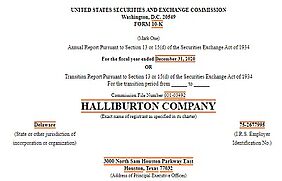Halliburton Company is one of the world's largest providers of products and services to the energy industry. The Company has approximately 40,000 employees, representing 130 nationalities in more than 70 countries. Halliburton provides a comprehensive range of services and products to the energy industry. The Company´s revenue is generated from the sale of services and products to major, national, and independent oil and natural gas companies worldwide. In 2020, 2019, and 2018, based on the location of services provided and products sold, 38%, 51%, and 58%, respectively, of consolidated revenue was from the United States. No other country accounted for more than 10% of revenue.
The Company operates under two divisions: the Completion and Production segment and the Drilling and Evaluation segment. Completion and Production delivers cementing, stimulation, intervention, pressure control, specialty chemicals, artificial lift and completion products and services. Drilling and Evaluation provides field and reservoir modelling, drilling, evaluation and precise wellbore placement solutions.
According to the Annual Financial Report the Company generated revenue of $14.4 billion in 2020, a decrease of $8.0 billion, or 36% from the $22.4 billion of revenue generated in 2019, mainly due to lower activity and pricing in North America land, primarily associated with stimulation services and well construction. Revenue from North America was 40% of consolidated revenue in 2020 and 53% of consolidated revenue in 2019. The revenue decline in 2019 was 7% compared to 2018.
In 2020 Halliburton reported total operating loss of approximately $2.4 billion driven by $3.8 billion of impairments and other charges. This compares to operating loss of $448 million in 2019 that was driven by $2.5 billion of impairments and other charges. A significant decline in pressure pumping services in North America land during 2020 negatively impacted operating results, partially offset by increase in stimulation activity and completion tool sales in the Middle East & Asia.
Geographically, North America revenue declined by 52% from 11.9 billion to $5.7 billion in 2020 compared to 2019, resulting from lower activity and pricing in North America land, primarily associated with reduced stimulation and well construction activity. While the U.S. land rig count recovered from its August 2020 low, it is still 60% below pre-pandemic levels. Even without improved pricing, Halliburton took advantage of the recovery in completions and drilling activity in the fourth quarter of 2020 and delivered margin improvements in North America.
Internationally, revenue declined by 17% in 2020 compared to 2019 primarily driven by reduced activity for drilling and completion related services across all international regions. Internationally, rig count and customer spending declined by more than 20%. Despite this tough backdrop, the Company improved its overall international margin in 2020.
Latin America revenue was $1.7 billion in 2020, a 29% decrease compared to 2019, resulting primarily from decreased activity in multiple product service lines in Argentina, Colombia, Ecuador, and Brazil, partially offset by increased project management activity in Mexico and drilling-related services in Guyana.
Europe/Africa/CIS revenue was $2.8 billion in 2020, a 14% decrease compared to 2019. The decrease was due to lower activity for multiple product service lines throughout the region, primarily in Nigeria, Egypt, and United Kingdom, partially offset by increased completion tool sales in the North Sea, Algeria, and Azerbaijan, and drilling-related activity in the North Sea.
Middle East/Asia revenue was $4.2 billion in 2020, a 13% decrease compared to 2019. The decrease was due to lower activity throughout the region, primarily related to project management, stimulation in Saudi Arabia, and well construction activity, partially offset by increased completion tool sales and pipeline services in the Middle East/Asia.
Completion and Production revenue was $7.8 billion in 2020, a decrease of $6.2 billion, or 44%, compared to 2019. Operating income was $1.0 billion in 2020, a 40% decrease from $1.7 billion in 2019. These results were primarily driven by reduced activity and pricing for pressure pumping services, lower completion tool sales, and reduced artificial lift activity in North America land.
Drilling and Evaluation revenue was $6.6 billion in 2020, a decrease of $1.8 billion, or 21%, from 2019. These results were primarily driven by lower activity for drilling-related services in North America land, lower project management activity in the Middle East & Asia, and a global decrease in wireline activity. Operating income was $569 million in 2020, a decrease of $73 million, or 11%, compared to 2019. These results were primarily driven by a decline in drilling activity in North America land.
During 2020, capital expenditures were approximately $728 million, a decrease of 52% from 2019. In 2021 Halliburton intends for capital expenditures to remain relatively flat at $750 million. Lower capital intensity, aided by technological innovation, should contribute to ongoing cash flow generation.
In the second quarter of 2020 Halliburton reduced its quarterly dividend rate from $0.18 per common share to $0.045 per common share and remained at this amount for the rest of 2020, reducing cash outflows by approximately $360 million in 2020. The Company will continue to maintain its focus on liquidity and review its quarterly dividend considering priorities of future debt reduction and reinvesting in its business.
For the full year of 2021, provided that the impact of the pandemic moderates, economic activity continues to increase, and commodity prices remain strong, the Company believes that customers will sustain activity in order to hold their production flat to 2020 exit levels.
